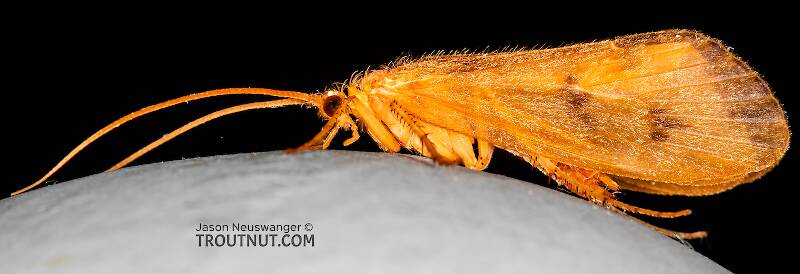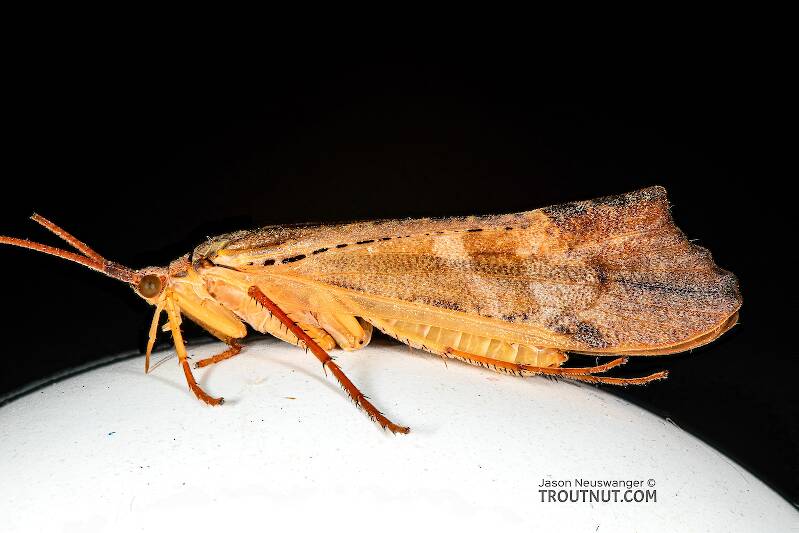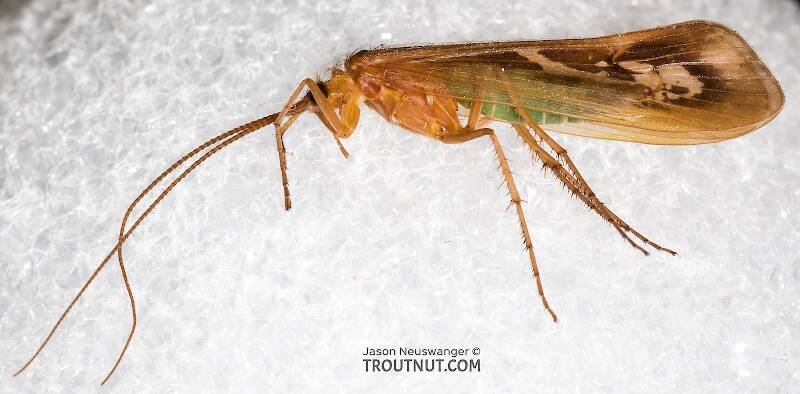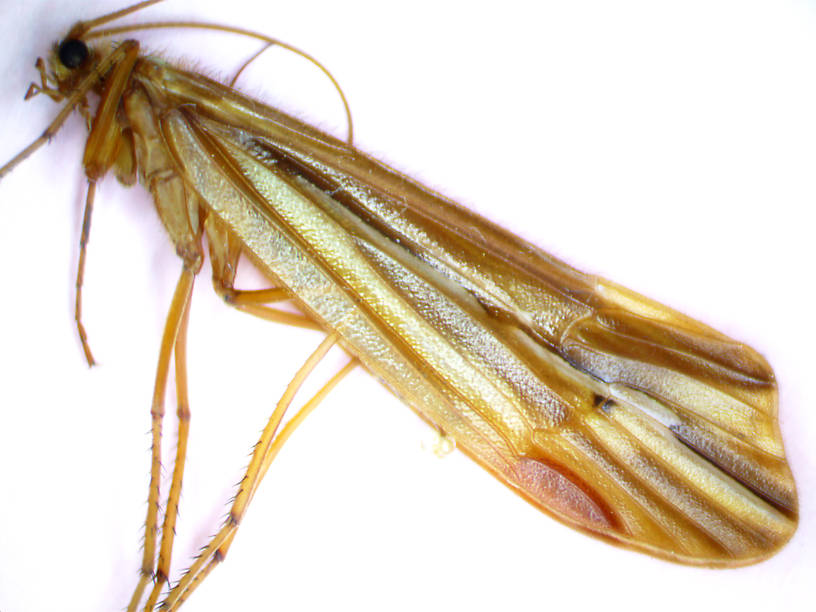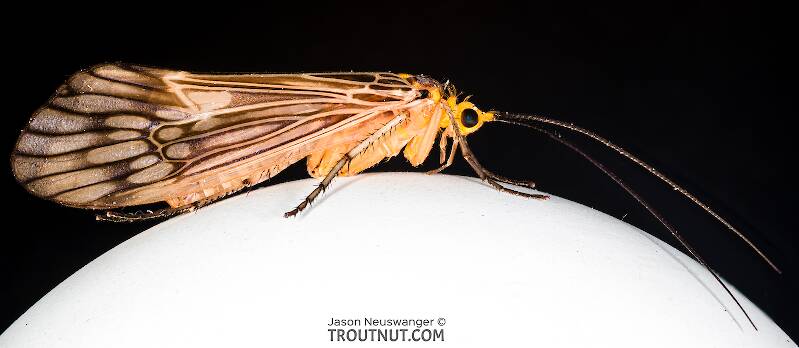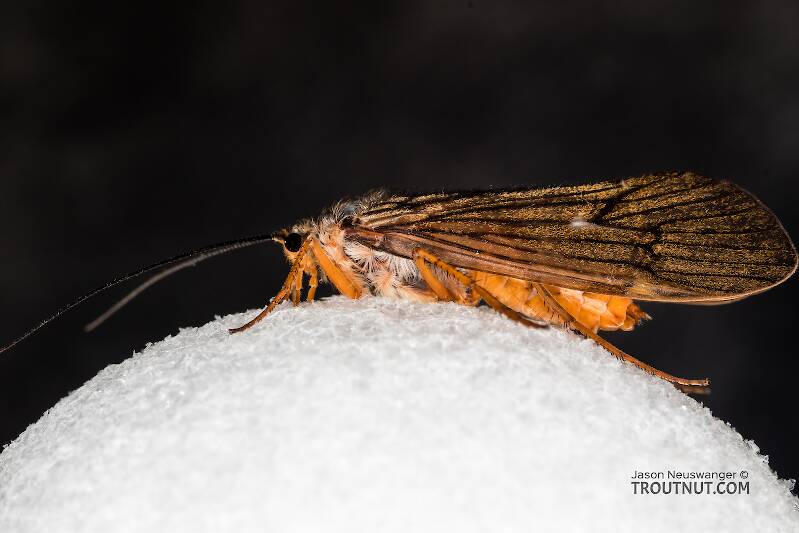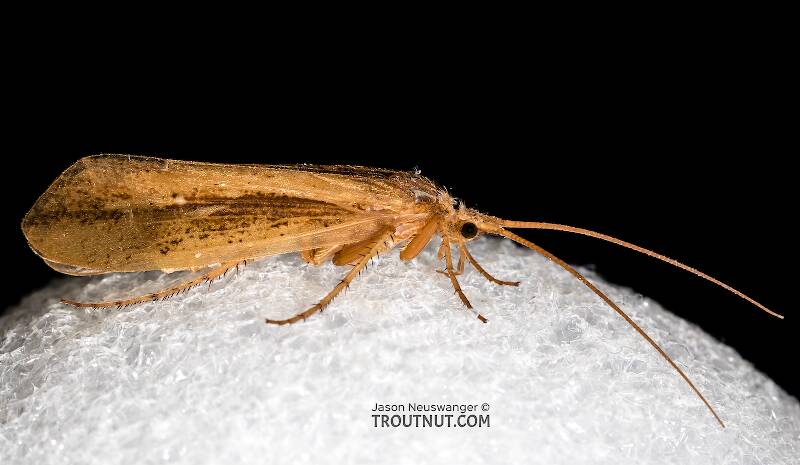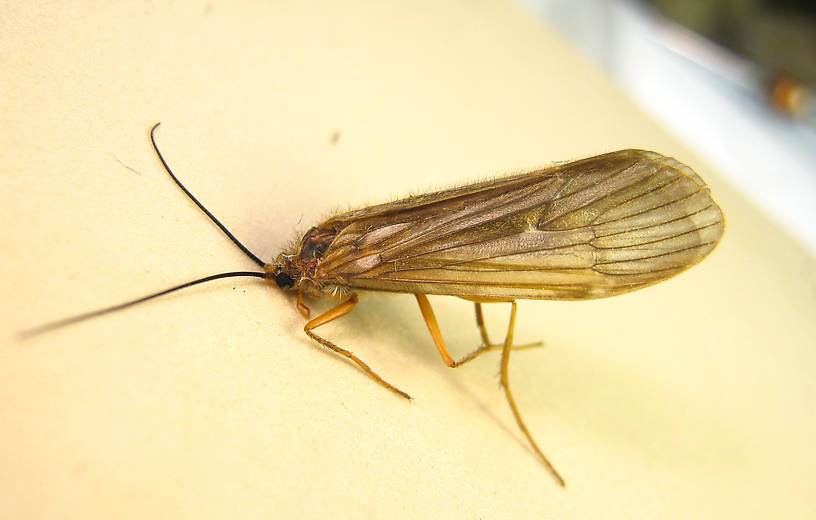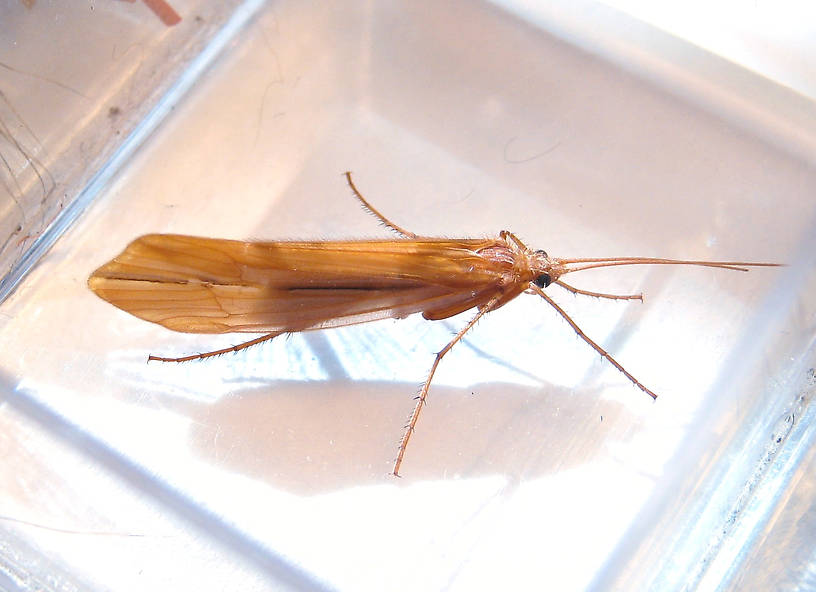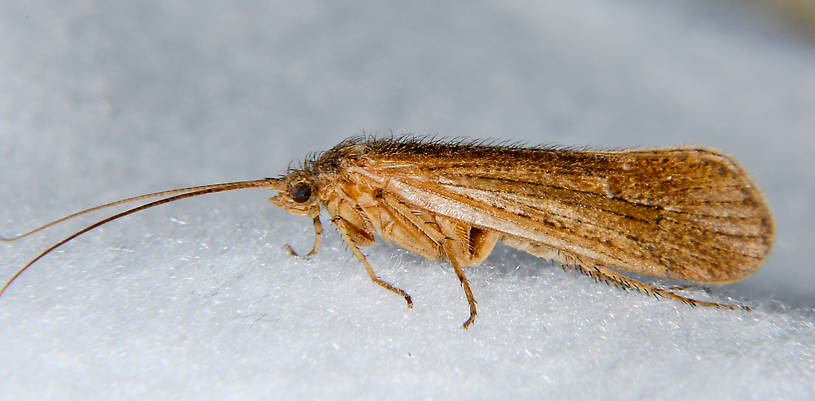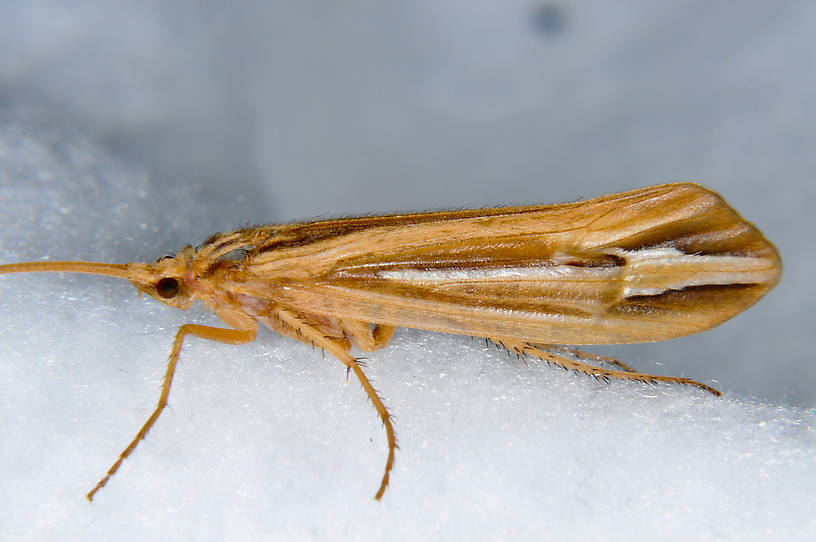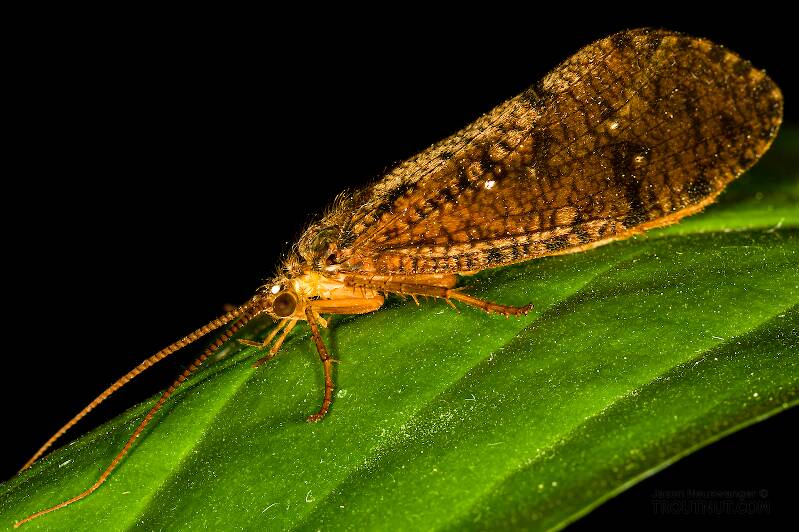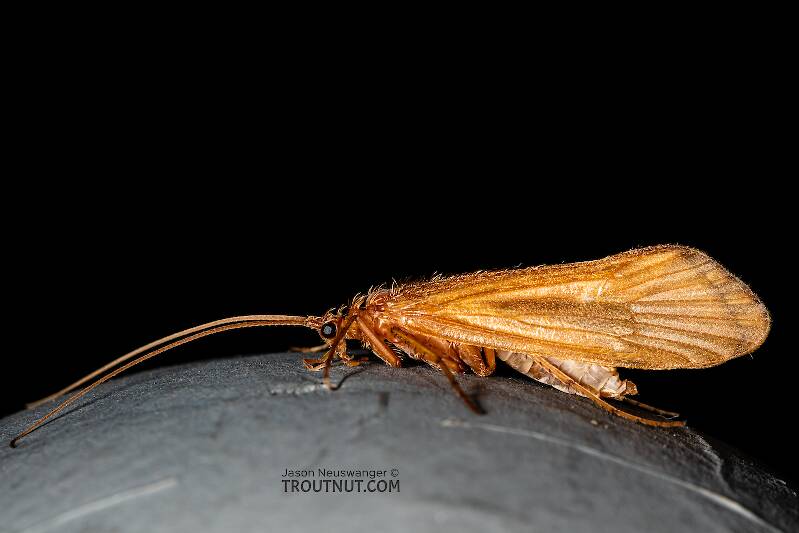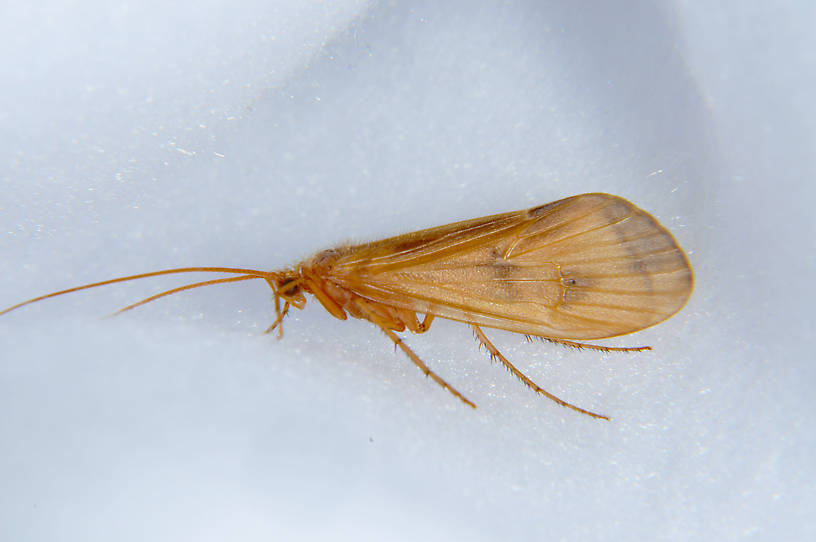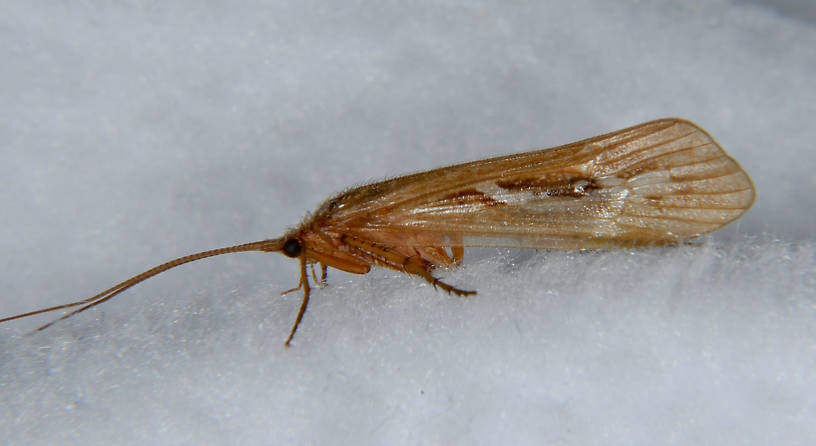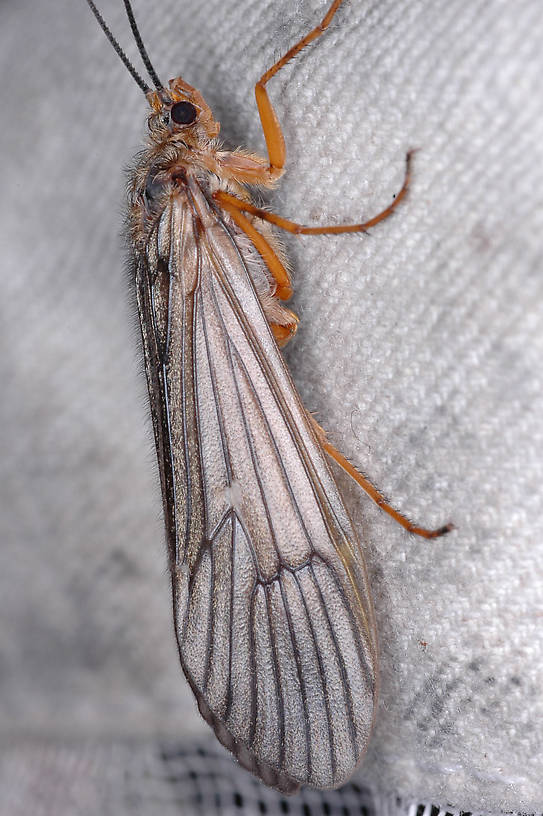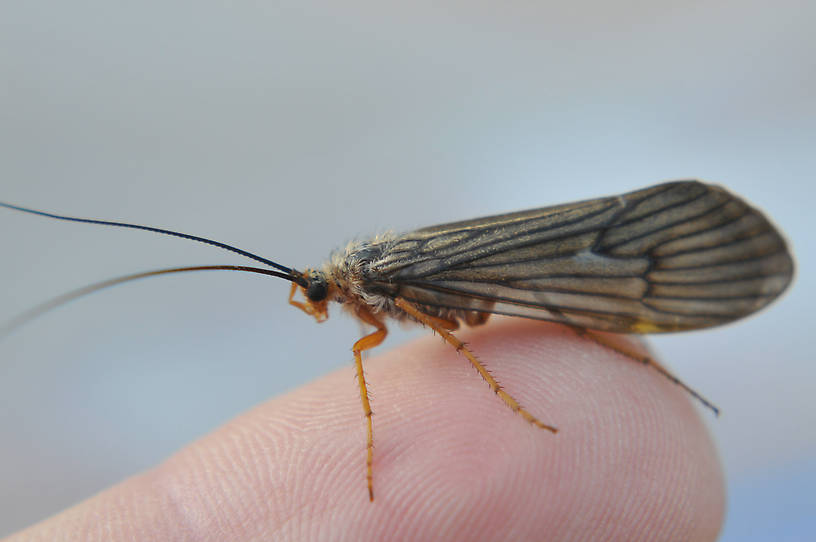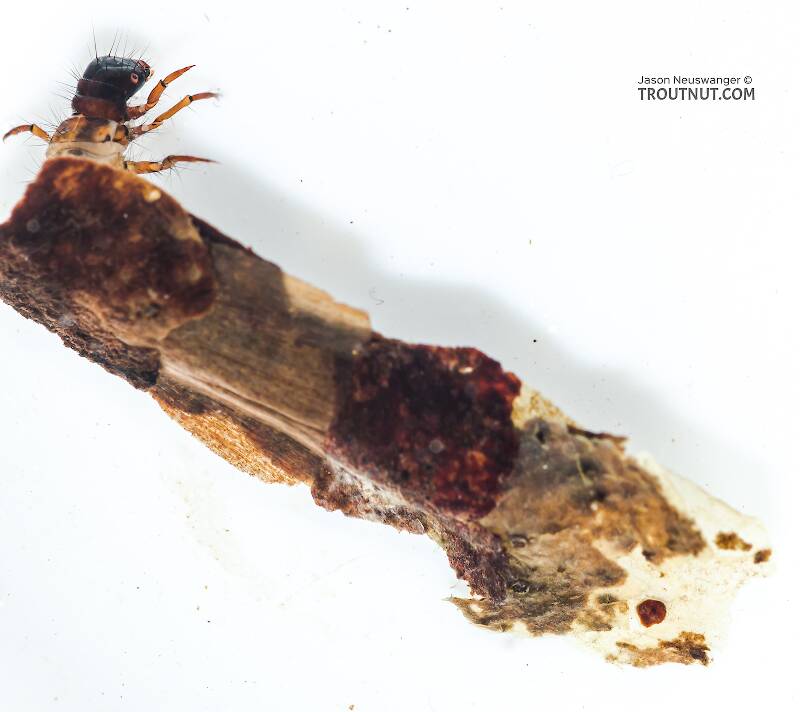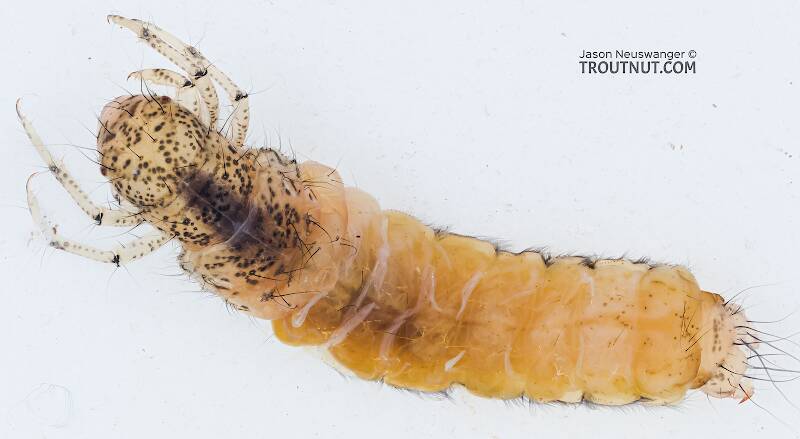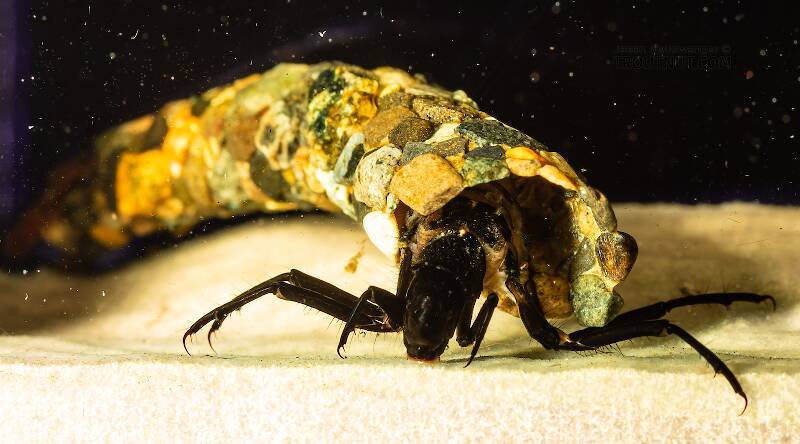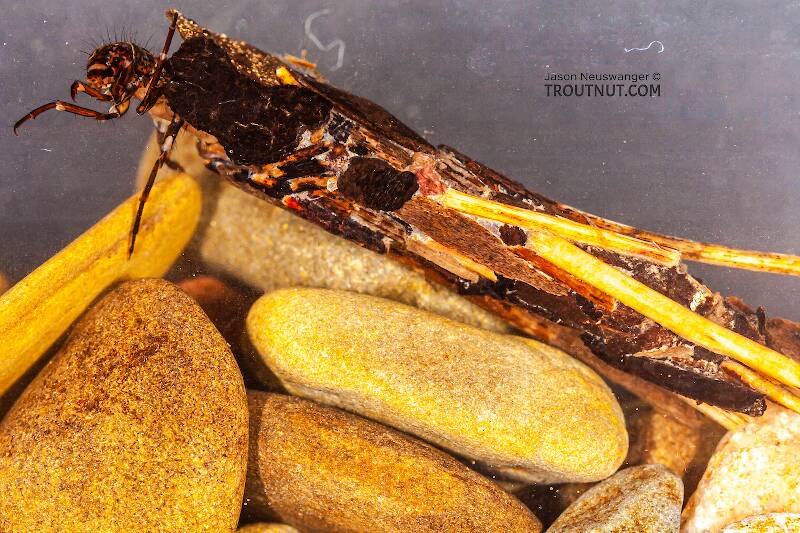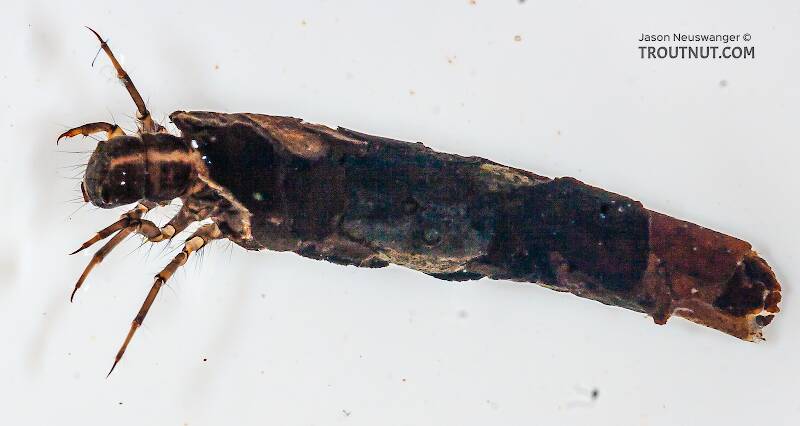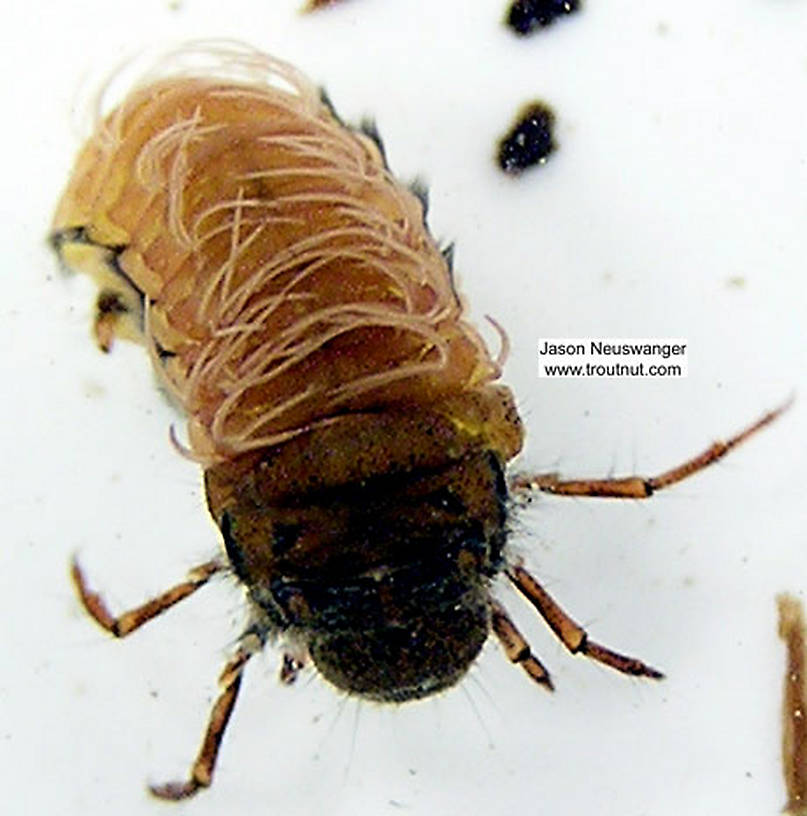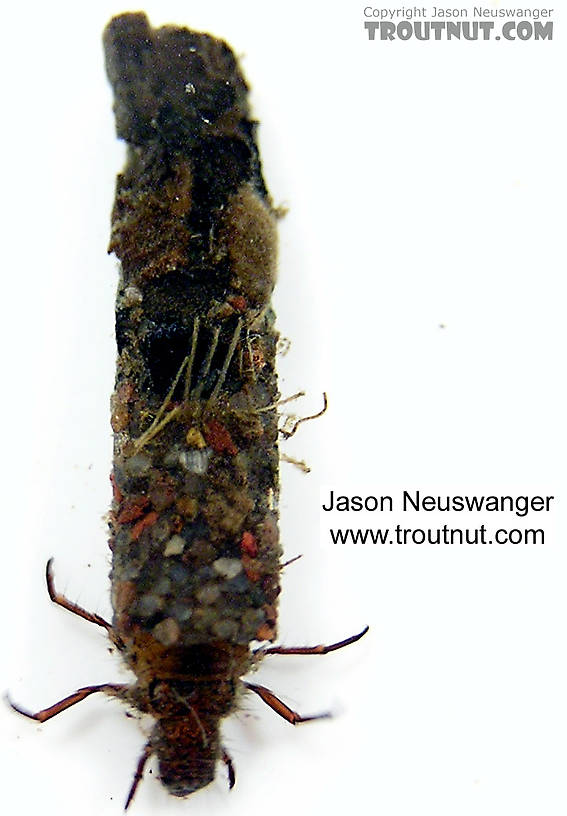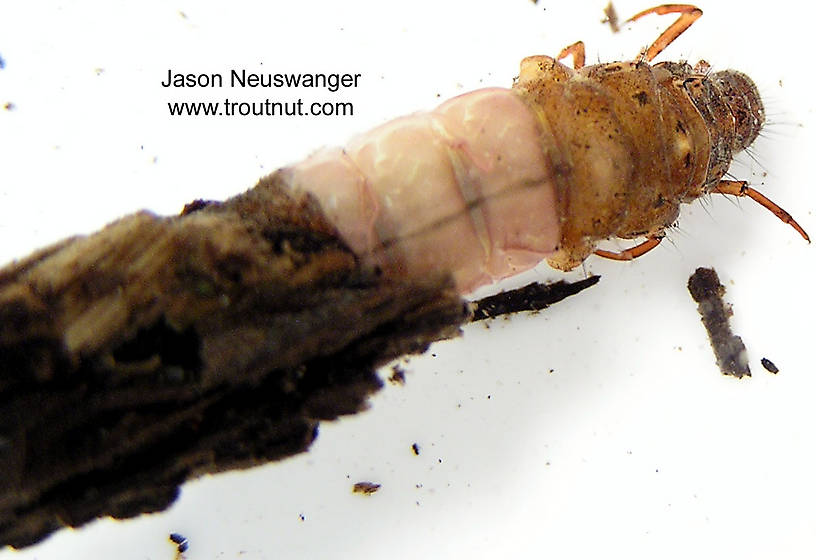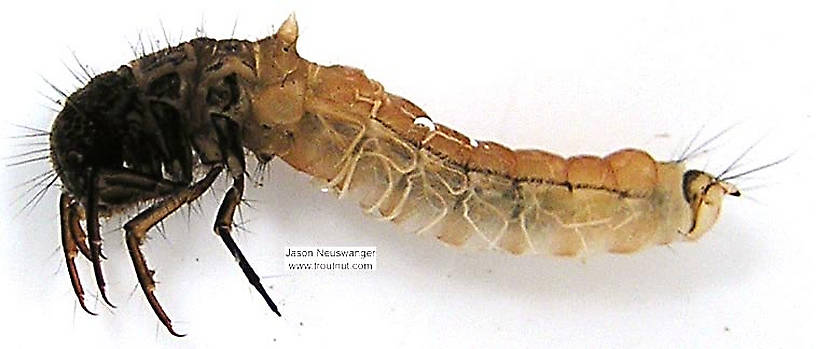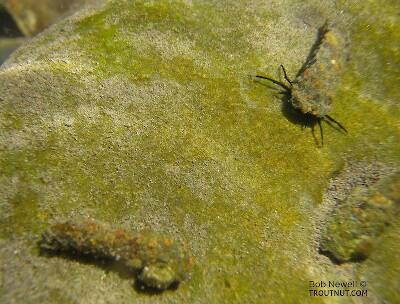
Hex Mayflies
Hexagenia limbata
The famous nocturnal Hex hatch of the Midwest (and a few other lucky locations) stirs to the surface mythically large brown trout that only touch streamers for the rest of the year.
Featured on the forum

I caught this tiny larva without a case, but it seems to key pretty clearly to to Glossosomatidae. From there, the lack of sclerites on the mesonotum points to either Glossosoma or Anagapetus. Although it's difficult to see in a 2D image from the microscope, it's pretty clear in the live 3D view that the pronotum is only excised about 1/3 of its length to accommodate the forecoxa, not 2/3, which points to Glossosoma at Couplet 5 of the Key to Genera of Glossosomatidae Larvae.

Troutnut is a project started in 2003 by salmonid ecologist Jason "Troutnut" Neuswanger to help anglers and
fly tyers unabashedly embrace the entomological side of the sport. Learn more about Troutnut or
support the project for an enhanced experience here.
Caddisfly Family Limnephilidae (Giant Sedges)
This huge family appropriately contains huge caddisflies. Many of its genera are important, but the western genus Dicosmoecus (the Giant Orange Sedge or October Caddis) is especially important as a big-trout hatch.
Limnephilidae contains so many species that it is difficult to generalize about them all. LaFontaine commented on the task in Caddisflies:
I recommend learning which genera or species are prevalent in your area and studying them specifically.
Limnephilidae contains so many species that it is difficult to generalize about them all. LaFontaine commented on the task in Caddisflies:
The fact that fly fishermen need broad principles of biology, not a collection of exceptions, makes it difficult to handle this family.
I recommend learning which genera or species are prevalent in your area and studying them specifically.
Where & when
There are species in this family for any type of water, but it's worth nothing that many species or genera exist mostly or entirely in lakes and ponds.Many species enter diapause during the summer to coordinate their fall emergence so that all individuals emerge within a few weeks and have no trouble locating mates.
In 4189 records from GBIF, adults of this family have mostly been collected during August (25%), July (22%), June (16%), September (15%), October (8%), and May (7%).
In 2081 records from GBIF, this family has been collected at elevations ranging from -30 to 38927 ft, with an average (median) of 1921 ft.
Family Range
Egg-Laying behavior
Many Limnephilidae females lay their eggs on dry land near the water, waiting for them to be washed in by rain or taken by floods. Others dive to the bottom to lay eggs.Larva & pupa biology
Diet: Algae, decaying leaves and wood, decaying animals
Shelter type: Tube with silk on the inside and plant matter, sand, or gravel on the outside
Specimens of the Caddisfly Family Limnephilidae
4 Male Adults
7 Female Adults
6 Adults
15 Larvae
1 Underwater Picture of Limnephilidae Caddisflies:
Discussions of Limnephilidae
october caddis
Posted by Amosg on Oct 6, 2011 in the genus Dicosmoecus
Last reply on Oct 6, 2011 by Amosg
In Alberta they exist in very small numbers but are not important to fishermen--Amos
You Western anglers - any experience with the Giant Orange Sedges?
7 replies
Posted by Troutnut on Jul 29, 2006 in the genus Dicosmoecus
Last reply on Jan 7, 2009 by Dgracia
This seems to be a very important insect for which I have no experience and few sources. I want to be sure that my writeup is accurate and fairly complete. Do any of you who fish out west know any details I've left out?
October Caddis
19 replies
Posted by Taxon on Jul 29, 2006 in the genus Dicosmoecus
Last reply on Oct 24, 2008 by Jack_k
Jason-
In the Pacific NW, Dicosmoecus are generally referred to as either October Caddis or Fall Caddis. The field guide I generally recommend for western fly fishers is Hatch Guide For Western Streams by Jim Schollmeyer. This is what he has to say about Dicosmoecus pupae, and I believe it clarifies any ambiguity of the passage you quoted from Caddisflies:
In the Pacific NW, Dicosmoecus are generally referred to as either October Caddis or Fall Caddis. The field guide I generally recommend for western fly fishers is Hatch Guide For Western Streams by Jim Schollmeyer. This is what he has to say about Dicosmoecus pupae, and I believe it clarifies any ambiguity of the passage you quoted from Caddisflies:
In the early or mid summer, the larvae reach maturity and move from the faster currents to the slower flows that are generally found along the margins of the stream. Then they attach their cases to the rocks, seal themselves inside, and begin pupation. This transformation takes about two months. When the pupae are ready to emerge anytime between late afternoon and dark, they chew open the front of their cases and swim or crawl to the surface. The ones that find exposed rocks cling to them close to or just above the waterline; their pupal shucks split open and the adults emerge. Larvae that took refuge and pupated behind unexposed mid-stream rocks pupate and emerge in the open water. Most pupae emerge from waters that are too shallow or too exposed for trout. Any pupae that emerge in deep or open waters are vulnerable as they swim to shore or the surface.
Great Autumn Brown Sedges on Potomac River
3 replies
Posted by BrettB on Oct 2, 2008 in the genus Pycnopsyche
Last reply on Oct 3, 2008 by GONZO
Came in to work today and noted several large Autumn sedges on doors facing river(18mm wing-to-head and 34mm total w/ antennae). Though more brownish-rusty than I remember them being, I'm relatively certain it is a Pycnopsyche due to the size, timing and dark markings near the rear mid-wing (sort of looks like a yin-yang symbol). Does anyone know of a good emerger fly for this hatch? I'm assuming it emerges in the evening through early morning. I may tie up some size 8 rusty elk hair caddis for adult imitations. Big bugs!
Apataniidae?
3 replies
Posted by GONZO on Oct 8, 2006
Last reply on Oct 9, 2006 by GONZO
I believe the genus Apatania is in its own family--Apataniidae. Also, because not all Limnephilidae are "giants," the most frequently used common name for this family is "Northern Caddisflies."
Start a Discussion of Limnephilidae
References
- LaFontaine, Gary. 1981. Caddisflies. The Lyons Press.
- Merritt R.W., Cummins, K.W., and Berg, M.B. 2019. An Introduction to the Aquatic Insects of North America (Fifth Edition). Kendall/Hunt Publishing Company.
- Parker, C. R., Wiggins, G. B. 1985. The Nearctic Caddisfly Genus Hesperophylax Banks (trichoptera: Limnephilidae). Canadian Journal of Zoology 63(10): 2443-2472.
- Schwiebert, Ernest G. 1955. Matching the Hatch. MacMillan Publishing Company.
- Swisher, Doug and Carl Richards. 2000. Selective Trout. The Lyons Press.
Caddisfly Family Limnephilidae (Giant Sedges)
Taxonomy
Genus in Limnephilidae
ChyrandaPale Western Stream Sedges
1
17
Clostoeca
1
11
DicosmoecusOctober Caddisflies
4
28
EcclisomyiaEarly Western Mottled Sedges
0
0
FrenesiaDot Wing Winter Sedges
0
0
Grammotaulius
2
20
HesperophylaxSilver Striped Sedges
2
16
HydatophylaxGiant Cream Pattern-Wing Sedges
1
12
IronoquiaEastern Box Wing Sedges
1
10
LimnephilusSummer Flier Sedges
8
45
Nemotaulius
1
15
OnocosmoecusGreat Late-Summer Sedges
6
57
PlatycentropusChocolate and Cream Sedges
1
3
PsychoglyphaSnow Sedges
2
5
PycnopsycheGreat Autumn Brown Sedges
3
38
Genus in Limnephilidae: Chyranda, Clostoeca, Dicosmoecus, Ecclisomyia, Frenesia, Grammotaulius, Hesperophylax, Hydatophylax, Ironoquia, Limnephilus, Nemotaulius, Onocosmoecus, Platycentropus, Psychoglypha, Pycnopsyche
26 genera (Allocosmoecus, Amphicosmoecus, Anabolia, Arctopora, Asynarchus, Chilostigma, Chilostigmodes, Clistoronia, Crenophylax, Cryptochia, Desmona, Ecclisocosmoecus, Eocosmoecus, Glyphopsyche, Grensia, Halesochila, Homophylax, Lenarchus, Leptophylax, Monophylax, Phanocelia, Philarctus, Philocasca, Pseudostenophylax, Psychoronia, and Sphagnophylax) aren't included.


